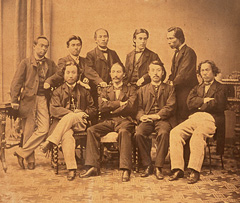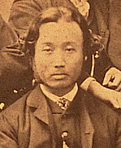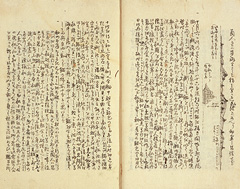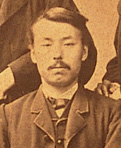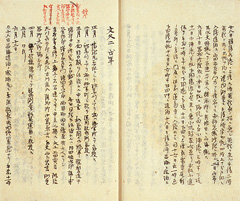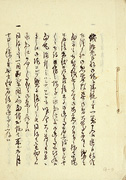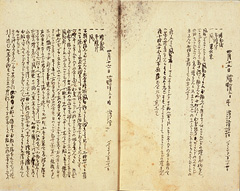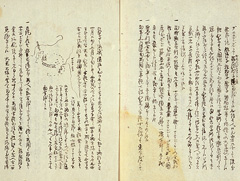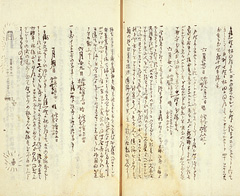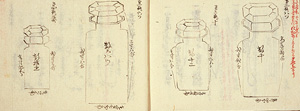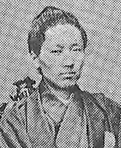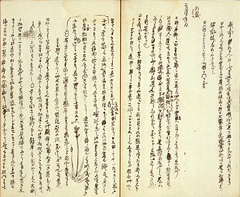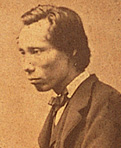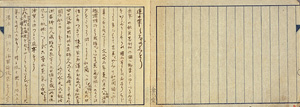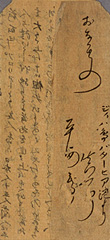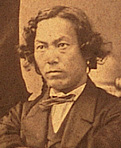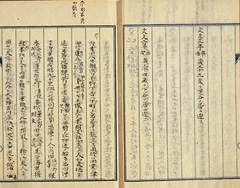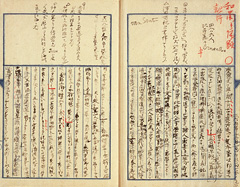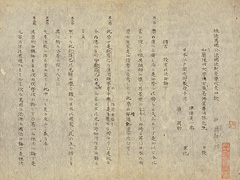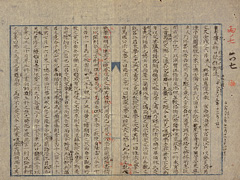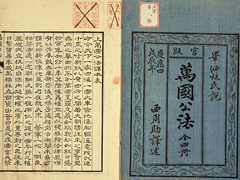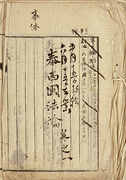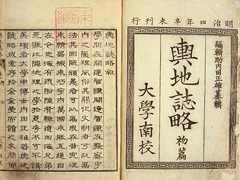This photograph was taken in the Netherlands in 1865. Back row from left is Ito Genpaku, Hayashi Kenkai, Enomoto Takeaki, (Fuse Kokichiro), and Tsuda Mamichi. Front row from left is Sawa Tarozaemon, (Hida Hamagoro), Akamatsu Noriyoshi, and Nishi Amane. Uchida Masao and Taguchi Shunpei were absent. The individuals shown in parentheses were not the students dispatched by the government.
Home | Part 2: View by Topics | 6. Students Studying in the Netherlands at the End of the Edo Period
Part 2: View by Topics
6.Students Studying in the Netherlands at the End of the Edo Period
After the arrival of Commodore M. C. Perry in 1853, the acquisition of Western science and technology became an urgent issue. The Shogunate government therefore drew up a plan to dispatch students to Western countries, and while the government initially planned to order its first warship from America and send its first students there, the outbreak of the U.S. Civil War forced it to drop those plans. Instead, it decided to make the requests to the Netherlands, and negotiations for the sale of a warship and the sending of students were successful. The members who received their orders on April 11, 1862 were Enomoto Takeaki (Kamajiro), Sawa Tarozaemon, Akamatsu Noriyoshi (Daizaburo), Uchida Masao (Kojiro), and Taguchi Shunpei from the Warship Navigation Institute, Tsuda Mamichi (Shin'ichiro) and Nishi Amane (Shusuke) from the Bureau for the Inspection of Barbarian Books as well as Ito Genpuku and Hayashi Kenkai who were receiving medical training at Nagasaki and seven other craftsmen who were technicians in casting, shipbuilding, etc. In the Netherlands, the students studied naval technologies, social sciences, medicine, and other subjects.
On July 14 of the same year, they boarded the Kanrin-maru and left Edo, arrived in Nagasaki on September 16, and then on November 2 set sail for Batavia on board the trading ship Calijpso. After being shipwrecked in the East Gaspar Straight of Sumatra on November 27, they arrived at Batavia on December 9, and then on March 26, 1863 they visited the historical site of Napoleon on the island of St. Helena before arriving in the Netherlands on June 2, 1863. They arrived at Leiden via Rotterdam, and then part of the group proceeded on to The Hague. They began their studies the next month.
Nishi and Tsuda were the first to return to Japan on December 1, 1865, followed in November 1866 by the others who returned home on the warship Kaiyo-maru that had been ordered by Japan with the exception of Ito, Hayashi, and Akamatsu. Akamatsu returned on July 6, 1868 after the Restoration of Imperial rule, and Ito and Hayashi left the Netherlands to return to Japan on January 15, 1869.
Sawa Tarozaemon
|
Sawa Tarozaemon (1835-1898) He was born in Edo, was in the navy, and learned Dutch studies. In 1857 he studied at the Navy Officer Training School in Nagasaki on the order of the Shogunate government. From 1862 to 1867 he studied in the Netherlands, where he mainly studied gunnery and gunpowder manufacturing methods. In October 1868, when Enomoto Takeaki escaped Edo and headed for Ezochi (Hokkaido) he boarded and fought on the Kaiyo-maru. After surrendering in June 1869, he was kept at the Kyumonkyoku Prison. He was pardoned in February 1872, and the next month joined the Army-Navy Ministry and later worked to build a gunpowder factory. |
Sawa Tarozaemon kokai nikki.
By Sawa Tarozaemon. Autograph. 1 v. <Akamatsu Noriyoshi documents, 29>
Akamatsu Noriyoshi
|
Akamatsu Noriyoshi (Daizaburo, 1841-1920) He was born in Edo and was in the navy. His father, Yoshizawa Yunoshin, was a vassal of the Shogun. He was adopted into the Akamatsu family. He studied the Dutch language, and in 1857 he was ordered by the Shogunate government to study surveying and navigation at the Navy Officer Training School in Nagasaki. In 1860, he journeyed to America aboard the Kanrin-maru. He studied in the Netherlands from 1862 to 1868, where he studied shipbuilding and science. He joined the Army-Navy Ministry in 1870 and later served as the dean of the Naval Academy. He was promoted to Rear Admiral in the navy in 1874, made a baron and promoted to Vice Admiral in 1887, and made Commander-in-Chief of the Sasebo Naval Division in 1889. He became a member of the House of Peers in 1904. |
Nikki.
By Akamatsu Noriyoshi. Autograph. 1 v. <Akamatsu Noriyoshi documents, 21>
Akamatsu Noriyoshi shokan, Yoshizawa Kinshiro ate.
Written in 13 Oct. 1862 by Akamatsu Noriyoshi. Autograph. 1 v. <Akamatsu Noriyoshi documents, 3-39>
Kokai nikki. v. 2(i.e. 3)
By Akamatsu Noriyoshi. Autograph. 1 v. <Akamatsu Noriyoshi documents, 32>
This is the last of the three remaining voyage journals of Akamatsu Noriyoshi. The 'No.2' written on cover is a mistake and should be 'No.3'. It covers the period from March 29 to June 5, 1863 from the departure of the island of St. Helena to the arrival in Leiden. This image shows the entries from June 2 when making port in Brouwershaven until June 5.
Akamatsu Noriyoshi shokan, Yoshizawa Genjiro ate.
Written in 5 June 1863 by Akamatsu Noriyoshi. Autograph. 1 v. <Akamatsu Noriyoshi documents, 3-42>
Oranda taizai nikki.
By Akamatsu Noriyoshi. Autograph. 1 v. <Akamatsu Noriyoshi documents, 34-1>
This journal covers the stay in the Netherlands from June 22, 1863 to May 23, 1865. It recorded in detail the Japanese calendar date, Gregorian calendar date, number of days since departing Edo, and number of days since arriving in the Netherlands. On August 14, 1863, Akamatsu, Hayashi and Enomoto observed a steel plate hardness test. On October 18, he went to Rotterdam, and on March 28, 1864 he visited a shipyard.
Uchida Masao
|
Uchida Masao (Kojiro, 1839-1876) He was born in Edo, and his father, Mannen Saburobe, was a vassal of the Shogun. He was adopted by the Uchida family. He learned Dutch studies. In 1857, he was ordered by the Shogunate government to study at the Navy Officer Training School in Nagasaki. He studied in the Netherlands from 1862 to 1867, where he studied navy related technologies. After returning to Japan, he worked at the Kaiseijo, and then in 1873 he resigned from the Education Ministry. His translations include Futsukoku keiho chushaku and Chigaku kyojuhon. |
|
Uchida Masao nikki.
By Uchida Masao. Autograph. 1 v. <Akamatsu Noriyoshi documents, 30>
Uchida Masao shokan, Akamatsu Daizaburo ate.
Written in 21 Jan. 1867 by Uchida Masao. Autograph. 1 sheet. <Akamatsu Noriyoshi documents, 13-1>
This is written in pen on Western paper. It is a letter written by Uchida from the Port of Rio de Janeiro, while returning by ship to Japan, to Akamatsu Daisaburo who was still studying in the Netherlands. Dutch words written in Japanese katakana syllabary are mixed into the Japanese text. He reports that the return ship (Kaiyo-maru) is sturdy.
Tsuda Mamichi
|
Tsuda Mamichi (Shin'ichiro, 1829-1903) He was born in Tsuyama, was a Western studies scholar, and an Enlightenment thinker. His father was the samurai of the Tsuyama Domain. He studied Confucianism and enjoyed Japanese literature. He went to Edo to study Dutch and military science. In 1857, he became an assistant to an instructor at the Bureau for the Inspection of Barbarian Books of the Shogunate government, and from 1862 to 1865 stayed in the Netherlands studying natural law and international public law together with Nishi Amane. In 1869, he became a penal law judge, while participating in the Meiroku-sha, and presented papers in the Meiroku zasshi. He became a member of the Chamber of Elders in 1876, a member of the House of Representatives in 1890, and later a member of the House of Peers. |
Hana no shiori.
By Tsuda Mamichi. Autograph. 1 v. <Tsuda Mamichi documents, 21>
This is a journal of his voyage from the time he sailed from Edo on July 14, 1862 until May 10 the next year. When he left Edo and arrived in Shimoda on July 15, there was a measles outbreak, but Tsuda wrote "I am not concerned, because I had them as a child." At places in his daily record he wrote poems.
Tsuda Mamichi shokan, Tsuda Naka ate.
Written in 14 Dec. 1862 by Tsuda Mamichi. Autograph. 1 sheet. <Tsuda Mamichi documents, 32>
Nishi Amane
|
Nishi Amane (Shusuke, 1829-1897) He was born in Tsuwano and was an Enlightenment thinker. His father was a physician of the Tsuwano Domain. He studied Confucianism at the domain school and in Osaka before going to Edo to learn Dutch and English. In 1857, he became an assistant to instructors at the Bureau for the Inspection of Barbarian Books, and from 1862 to 1865 stayed in the Netherlands studying natural law and international public law together with Tsuda Mamichi. In 1870, he joined the Army-Navy Ministry, participated in the Meiroku-sha, and presented papers in the Meiroku zasshi. He became a member of the Chamber of Elders in 1882, and a member of the House of Peers by Imperial command in 1890. He introduced Western philosophy, logic, and other studies and made many translations. He proposed many words to use in translation, such as Tetsugaku for philosophy. |
Nishi ke furyaku, rireki.
By Nishi Amane. Autograph. 1 v. <Nishi Amane documents, 1>
This is a chronological autobiography. He gives his family history and then writes his personal history from birth. With regard to his studies in the Netherlands, he mentions the order to study overseas in 1862, and records the period from the departure of Edo to making port at St. Helena. He then gives a summary of his studies of natural law, international public law, and other subjects in the Netherlands. This material was used in Nishi Amane den written by Mori Ogai.
Oranda kiro kiko.
By Nishi Amane. Autograph. 1 v. <Nishi Amane documents, 12>
This is a record of his return trip from the departure from Leiden in 1865, sightseeing in Paris on the way, to the arrival to Japan. The notes on the cover and margins are said to have been made by Mori Ogai. At the end of the book is written "Journal ends in February 1884 (Meiji 17)" but this was a writing error for 1894 (Meiji 27). This material was also used in Nishi Amane den written by Mori Ogai.
Impact on Scholarship after the Meiji Era
Some of the students dispatched to the Netherlands had a major impact on the introduction of the social sciences during the Meiji era, as a result of their writings based on what they had learned during their overseas studies.
Nishi Amane and Tsuda Mamichi studied the following five subjects from Simon Vissering (1818-1888) who taught economics and politics at the University of Leiden: Natuurregt (natural law), Volkenregt (international public law), Staatsregt (national law), Staatshuishoudkunde (economics), and Statistiek (statistics). These were called the Goka (five subjects), and after their return to Japan, they translated and published these lectures.
Uchida Masao also edited works using what he had learned during his overseas studies.
Seiho bankoku koho kokuho seisangaku seihyo koketsu.
By Hisserin. Tr. by Nishi Amane. Ms. 1 sheet. <Nishi Amane documents, 31a>
Ki goka jugyo no ryaku.
By Nishi Amane. Autograph. 2 sheets. <Nishi Amane documents, 31>
This is an account of the five subjects Nishi studied in the Netherlands. It was made after he returned to Japan. This is a draft of the introduction to Seiho setsuyaku, the lecture of S. Vissering that Nishi Amane planned to translate and publish. It was also created as the preface for the translations of the five subject lectures to be published, because Seiho setsuyaku is the first book of these lecture notes.
Bankoku koho.
By Hisserin. Tr. by Nishi Amane. S.l.: s.n., 1868. 4 v. <Nishi Amane documents, 186-1>
This is a translation by Nishi Amane of the S.Vissering's lectures on international public law. This translation became the forerunner of introductory works on international public law together with the Chinese translation of Elements of international law written by Henry Wheaton, that was translated by William Martin, a missionary living in China and reprinted in Japan in 1865: .
Taisei kokuho ron. Makino ichi. Soko.
By Simon Hiserinku. Tr. by Tsuda Mamichi. Autograph. 1 v. <Tsuda Mamichi documents, 5>
This is a translation draft of the lectures on national law by S. Vissering. Many corrections can be seen. The clean copy was presented to the Shogunate government and was published in 1868. Thereafter, it was republished during the beginning of the Meiji era and was widely read. Lectures on statistics was also translated by Tsuda and published in 1874 by the Statisitcs Division of the Dajokan under title: Hyoki teiko.
Yochishi ryaku.
Edited and tr. by Uchida Masao. Tokyo: Monbusho, 1871-80. 12 v. <YDM22353>
This work was edited and translated using Dutch books by J. Kramers in addition to English and other books. It has many illustrations and is based on materials collected while Uchida was studying in the Netherlands. It was published by the Daigaku Nanko (predecessor of Tokyo University) in 1870, and was widely read thereafter with many editions being published. The editing of Volumes 11 and 12 was continued by Nishimura Shigeki after the death of Uchida.
Navigation
-

-

-
Study of Japan by
Foreigners Coming to
Japan -
Activities of Dutch Studies
Scholars -
Studying the Dutch
Language -
Receiving Knowledge form
Overseas -
Acceptance of Western
Military Science at the
End of the Edo Period -
Students Studying in the
Netherlands at the End of
the Edo Period
-
Study of Japan by
Copyright © 2009 National Diet Library. Japan. All Rights Reserved

